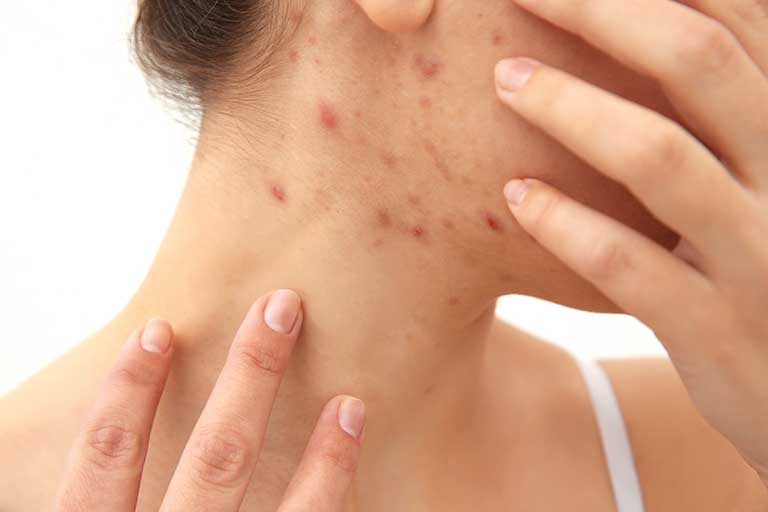Acne: Diagnosis
Acne is a skin disorder that usually appears in adolescence and causes blackheads and pimples. Acne can leave scars and have psychological repercussions. Therefore, it is important to treat it early.

How is acne diagnosed?
Acne vulgaris is usually diagnosed through a physical examination.
Routine microbiologic testing is not recommended in the evaluation and management of patients with acne. However, those who exhibit acne-like lesions suggestive of Gramnegative folliculitis may benefit from microbiologic testing.
Routine endocrinologic evaluation (eg, for androgen excess) is not recommended for the majority of patients with acne. However, laboratory evaluation is recommended for patients who have acne and additional signs of androgen excess.

Medical History:
A complete medical history of the patient must be performed, including:
- Current age and onset of acne.
- Medication history.
- In the case of women, a history of their period must be included, together with frequency and association with acne outbreaks.
- History of diseases.
- Family history of acne.
- Signs of virilization in small children or women, such as increase in pubic hair, male pattern hair loss, genital enlargement or deepening of the voice.
- Symptoms in joints of patients with severe acne.
- Skin care habits.
- Current and previous treatments, and response to these treatments.
- Psychological impact of acne.
Once the medical history is completed, a physical examination must be conducted.

Physical Examination:
Visually check for lesions, type, distribution, stages of development, etc.
- Type: Close comedones, open comedones, inflammatory papules, inflammatory pustules, inflamed nodules.
- Distribution: Face, chest, shoulders, back or arms.
- Stages of the Lesion: Check if the lesions in an area are found in the same or different stages of development (typical of acne).
- Signs of Hyperandrogenism: Suspicion of abnormal increase in androgens, as it may happen with polycystic ovarian syndrome, congenital adrenal hyperplasia, and adrenal or ovarian tumors, signs of virilization in prepuberal men and women.
- Presence of Sequelae: Such as post-inflammatory hyperpigmentation and scarring, typical of acne vulgaris.
Differential Diagnosis
Although acne vulgaris is a common condition, often easy to diagnose, you should always be certain that it is not another disorder, such as a skin disease, acneiform rash and other non acneic disorders because it has a very similar appearance to acne. That is, a differential diagnosis must be performed. The diseases that must be ruled out include:
- Inflammatory Facial Lesions:
- Rosacea: It is a skin disease that occurs with facial redness but, as it progresses, papules, micropustules and nodules may appear.
- Periorificial Dermatitis: It occurs around the mouth or nose.
- Pseudofolliculitis of the Beard: More frequent in people with Afro hair, it may be due to short, shaved or cut hair in the beard area that rolled up towards the skin, penetrated it and caused an inflammatory reaction.
- Facial Angiofibromas in Tuberous Sclerosis: They usually occur during childhood, in cheeks and nose.
- Non-Inflammatory Facial Lesions:
- Sebaceous Hyperplasia: It is characterized by the visible enlargement of sebaceous glands, more commonly in adults with history of oily skin, more frequently in forehead and cheeks.
- Nevus Comedonicus: It occurs at birth or during childhood as groups or rows of comedones.
- Adnexal Tumors: They are benign follicular tumors shaped as skin-color facial papules.
- Favre-Racouchot Syndrome: It is a condition that occurs due to sun damage to the skin in the form of open and closed comedones, usually in upper lateral cheeks in adults of middle or advanced age.
- Trunk and Extremities: They present similar lesions to acne.
- Folliculitis: There are several types similar to inflammatory acne, but, unlike acne, lesions are found in the same stage of development and there are no comedones.
- Keratosis Pilaris: It is a common condition caused by plugging of the hair follicle, with small follicular papules in the upper arms or thighs, sometimes with redness, and that may also occur in the face, particularly in children.
- Suppurative Hidradenitis: It is a chronic, inflammatory skin disorder, with periodical inflamed nodules and abscesses, preferably in the armpits, groin, below the breasts or around the anus; scars and comedones can also be found as small channels that go from the infected area to the skin surface.
- Steatocystoma Multiplex: Rare genetic disorder with development of multiple yellow or skin-color cysts full of sebum. They occur in the trunk, upper arms or chest.
- Acneiform Rash: Disorder in which a rash very similar to acne occurs, but it is not associated with the real acne vulgaris.
- Drug-Induced Acne: This acne is induced by drugs such as glucocorticoids, lithium, isoniazid, androgens and phenytoin, and usually presents an inflammatory papular rash with lesions in the same stage of development.
- Neonatal Cephalic Pustulosis: Previously known as "neonatal acne," it is different from infantile acne because it occurs in the first weeks of life (infantile acne occurs between three and six months of age), with papules and inflammatory pustules in the face without comedones.
- Cosmetic Acne: Some cosmetic products may contain comedogenic ingredients (favoring the occurrence of comedones), which may lead to the formation of acne lesions. The improvement of the design of these products has reduced their presence in the market. Irritant reactions to cosmetic products can also cause a rash similar to acne vulgaris, but inflammatory lesions usually appear a few hours after applying the causing product.
- Mechanical Acne: It may occur due to contact with worn out clothes, such as high collars, suspenders, shoulders, orthopedic casts and sports helmets, which irritate pilosebaceous follicles and stimulate the formation of comedones.
- Occupational Acne and Chloracne: Occurrence of comedones, inflammatory papules, pustules, nodules or cysts as a result of exposure (direct contact, inhalation of vapors or ingestion) to certain chemical products, such as insoluble cutting oils used in machines to work metal and derivatives of tar of coal and chlorinated hydrocarbons.
References
- Thiboutot D, Zaenglein A. Pathogenesis, clinical manifestations, and diagnosis of acne vulgaris. UpToDate. 2015;1–51. Available at: https://www.uptodate.com/contents/pathogenesis-clinical-manifestations-and-diagnosis-of-acne-vulgaris?search=pathogenesis-clinical-manifestations-and-diagnosisof-acne-vulgaris&source=search_result&selectedTitle=1~150&usage_type=default&display_rank=1
- Zaenglein AL, Pathy AL, Schlosser BJ, Alikhan A, Baldwin HE, Berson DS, et al. Guidelines of care for the management of acne vulgaris. J Am Acad Dermatol. 2016 May 1;74(5):945-973.e33. Available at: https://www.ncbi.nlm.nih.gov/pubmed/26897386

